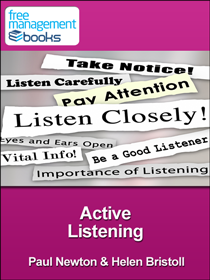Active Listening - Free eBook in PDF Format
 |
 |
|
Book Description - ISBN 978-1-62620-963-3 (30 Pages)
Talking to other people one-to-one makes up a significant proportion of the total amount of communication that you are involved in each day. Active listening will reduce the chance of misunderstandings, help to solve problems, and allow you to take advantage of opportunities you may have previously missed. This free eBook describes what active listening is and how it can make you a more effective manager.
Chapter 1 - Active Listening Skills for Managers
Active listening is a straightforward technique that you can use to improve your communication skills. It involves listening for meaning, in a neutral and non-judgmental way.
Chapter 2 - Active Listening Skills - Definition of Active Listening
There are three components of active listening that you need to understand in order to master this essential communication skill. These are listener orientation, the reflective technique and questioning skills.
Chapter 3 - Reflective Technique for Active Listening
Reflection involves reflecting back to the speaker what it is you believe they mean. This technique increases your own understanding, helps the speaker to clarify his or her own thoughts, and can reassure them that you are interested in their point of view. A mixture of reflection and direct questioning can get to the bottom of what people mean.
Chapter 4 - Questioning Skills for Active Listening
Questions can help you to focus attention, elicit new ideas, encourage exploration, and foster commitment. There are seven different types of question you can use: open, probing, closed, reflective, leading, hypothetical, and paraphrasing.
Chapter 5 - Barriers to Active Listening
There are many barriers to active listening, including physical and cultural factors such as a noisy environment, a strong regional accent, or a difference in terms of reference. There are also barriers that you can create yourself if you are not careful. These include: inappropriate nonverbal cues, taking the spotlight, stereotyped reactions, inappropriate responses, pretending understanding, overreaching and under-reaching, and long-windedness.
Chapter 6 - Advantages of Active Listening
The elements of listening orientation (empathy, acceptance, congruence, and concreteness) are likely to increase as the reflective listening process continues. These are the ingredients you need for an open, trusting relationship with your team members.
Active Listening Tips - Good listeners' detach themselves from their own concerns, attitudes, and ideas whilst they are listening. You achieve this by removing such distractions allowing you to observe both the conscious and unconscious signs of the speaker. You are then able to identify any discrepancies between these two signs and discern the true meaning of what has been said.
| You will learn: |
|
![]()
![]()
Gives you some great takeaways
Communications skills are something that I know I can always use work on, so I picked out the 'Active Listening' title and gave it a read. I am somewhat familiar with the concepts involved with active listening, but admittedly haven't thought about this topic in quite some time. Figuring it was time for a review, I was pleased to find that I learned quite a bit from this relatively short book. It is an easy read with plenty of illustrations, yet doesn't lack for meaningful content that I imagine a wide range of people will find useful.
It is my opinion that the skill of listening in general has taken a significant hit since the popularity of devices like smart phones and tablets took off a few years ago. Many conversations now take place with one or both people staring down at their screen while trying to 'listen'. The result is that many conversations are useless, forgotten, and a waste of time. This book on active listening is a great reminder that listening to the other person speak in a conversation is important and a skill all its own. I am certainly guilty of distracted listening myself, and hope to be better about it in the future.
One of the interesting distinctions that was made in this book regarding the practice of active listening was pointing out that it is important to not form opinions or judgments early in the conversation. I have always thought about active listening in terms of simply paying attention to what the other person is saying, but there is more to it than that. By giving them time to make all of their points, without interruption or early judgment, you can actually hear what they have to say before offering your two cents. Being an impatient person, I know that I have cut people off in the past, assuming I knew what they were going to say. The book points out how that can be a mistake, and I think they are correct with that conclusion.
Another section of this book that I found to be useful was the discussion of questioning skills. I sometimes find it difficult to ask questions in a business conversation without feeling like I am trying to take over or dominate the conversation. One of the mistakes I have likely made is that of asking closed questions, which this book points out. Questions that only have a 'yes' or 'no' answer tend to hurt the conversation and lead to one person doing most of the talking. I will try to avoid using these questions in the workplace to encourage more collaboration.
The section toward the later stages of this book on nonverbal cues hit home for me as I have a habit of standing with my arms crossed. This isn't intended to be a signal to the person that I am speaking with, but I can now see how I could appear tense or standoffish when taking this posture. If I can remember to do it, I am going to try and stand in a way that appears more relaxed and open.
I would be happy to recommend this guide on active listening because it contains a nice collection of solid advice on the topic without getting too dry or technical. It is long enough to give you some great takeaways that you can put into your everyday work life, but short enough to read in one sitting. If you are interested in improving your overall communication skills to hopefully perform better in the workplace, take a few moments and brush up on active listening.
Gerard Cohen
Could help you become a better manager
Right off the bat, the book describes exactly what active listening is. It turns out there is a lot more that goes into listening than I had previously thought. There are three different degrees of active listening. The three types are repeating, paraphrasing, and reflecting. I like that a chart is included in the book so that it easily lays out the similarities and differences between the three degrees. The chart made it very easy to understand the differences. Active listening involves giving the speaker your undivided attention. This book gives a list of tips that helps you become a better listener. The book states that being a good active listener could help you to be a better manager. Active listening can increase your team's productivity and also the level of motivation of the team.
One section of the book covered the components that go into being an active listener. The three components that the book describes are reflective technique, listener orientation, and questioning skills. The author does a good job of breaking each one of the components down so that they are easily understood. I like that there are several examples that are given of things to do or say to help in a conversation. For instance, during the question skills section, the author lists several questions that could be asked. I hadn't ever thought that there could be barriers that could interfere with active listening.
Some barriers that the author explains are physical, cultural, over/under reaching, stereotyped reactions, taking the spotlight, unsuitable responses, pretend comprehension, inapt nonverbal cues, and complex responses. Some tips the author gives are to face the speaker. Make sure that you aren't looking away from the speaker. Keeping direct eye contact is important to show that you are engaged with the speaker. Pretend comprehension is not going to help anyone. Try not to give very long responses because it can interrupt the flow of conversation. By taking the spotlight you are no longer being an active listener but rather you have become the speaker.
I had assumed that hearing someone was active listening. There really is so much more that goes into it then simply hearing the words that someone says. You have to be clear minded, paying attention to what the speaker says, and not have any barriers keeping you from processing what the speaker wants you to hear. I was really shocked and impressed by how much I learned from this book. When I started this book I had heard the term active listening, but I wasn't really sure what it meant. After reading this book, I have a thorough understanding of not only what active listening means but also how to improve my own skills. I found that this book was really useful to anyone wanting a promotion or someone who is hoping to improve the work environment of the team they are leading. The length of this book was perfect. I didn't want to spend hours and hours of my free time studying to improve my skills. I feel like this book helped me to be a better candidate for promotion in a reasonable about of time.
Simon O'Neil


